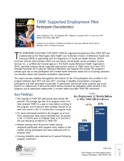This report describes 219 participants who enrolled in the Temporary Assistance for Needy Families Supported Employment Pilot (TANF SEP) between April 2015 and June 2017. The TANF SEP program used the Individual Placement and Support (IPS) model of supported employment services to help TANF clients with mental health and co-occurring substance abuse disorders obtain and maintain competitive employment. Individuals were eligible for participation in the pilot if they were unemployed and receiving TANF, met access to care standards for mental health treatment, expressed an interest in being employed, and lived in Skagit or Snohomish counties.
TANF SEP participants faced a variety of barriers to employment, including housing instability, poor employment history, behavioral health treatment needs, other chronic health conditions, criminal justice system involvement, and childcare needs. Despite these challenges, employment rates almost doubled for program participants who enrolled in the program by June 2016 between the pre- and post-periods, and housing instability rates decreased by 22 percent.
The report has two key limitations: (1) it is based on a small subset of TANF recipients in a restricted geographic area, so it may not be generalizable to Washington’s broader TANF population; and (2) the analysis did not use a comparison group necessary to assess the net effects of the program. It is unclear if the changes in observed outcomes in employment are due to participation in the program or other factors, such as participant motivation.
Report and/or Additional Information:
Categories:
Related Publications:
- 2003 County Profile of Substance Use and Need for Treatment Services (4.52)
- Adults on TANF in Washington State (11.158)
- Becoming Employed Starts Today (BEST) (3.44)
- Becoming Employed Starts Today (BEST) (4.107)
- Behavioral Health Risk among TANF Parents: Links to Homelessness, Child Abuse and Arrests (11.153)
- Characteristics of People with Apple Health and Stimulant Use Disorder Diagnosis in Washington State: Prevalence, Geographic Distribution and Healthcare Service Utilization over Five Years (Fiscal Years 2018 to 2022) (11.279)
- Characteristics of Public Housing Assistance Recipients in Washington State (11.223)
- Children on TANF in Washington State (11.159)
- Cost Savings in Medicaid Medical Expenses: An Outcome of Publicly Funded Chemical Dependency Treatment in Washington State (4.30)
- DSHS Children’s Administration/TANF Concurrent Benefit Program: Costs and Reunifications for SFY 2009 Removals (11.189)
- DSHS Economic Services Administration Service Trends Before and During the COVID-19 Pandemic (11.264)
- Effect of TANF Concurrent Benefits on the Reunification of Children following Placement in Out-of-Home Care (11.198)
- Employment Outcomes of Chemical Dependency Treatment and Additional Vocational Services Publicly Funded by Washington State (4.29)
- Employment Outcomes of Chemical Dependency Treatment: Analyses from Washington State (4.45)
- Housing Matters: Characteristics and Experiences of TANF Clients by Housing Status (11.211)
- Impact of Housing Assistance on Outcomes for Homeless Families (11.219)
- Improving Employment Outcomes for People with Mental Health Disorders in Washington State (11.230)
- Predicting Homelessness among Low-Income Families on TANF (11.224)
- Profile of Substance Use and Need for Treatment Services in Washington State (4.32)
- Serving TANF Families with Limited English Proficiency (6.53)
- Substance Abuse Treatment & Hospital Admissions: Analyses from Washington State (4.46fs)
- Substance Use, Substance Use Disorders, and Need for Treatment among Washington State Adults (4.25)
- TANF Caseload Changes: The Well-Being of Parents and Children Leaving WorkFirst in Washington State (11.280)
- TANF Caseload Decline (11.216)
- The Foundational Community Supports Program: Preliminary Evaluation Findings (11.251)
- Transportation Initiative: Evaluating the Impact of Expanded Transportation Support Services on Community Service Office Outcomes (6.67)
- Transportation Initiative: Expanding Transportation Support Services for WorkFirst Clients (6.66)
- WorkFirst Parents in Vocational Education at State Community and Technical Colleges: The Role of Basic Food Education & Training (6.62)

